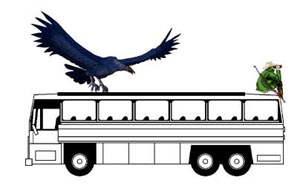Andean condors are impressive in their soaring majesty with a 3 metre wing span, but 6 million years ago, the world’s largest bird took to the skies with a wingspan the size of a Cessna 152 light aircraft. Now, Sankar Chatterjee and Jack Templin of the Museum of Texas Tech University and his colleagues have used computer software designed to model helicopter flight to reveal that although this bird could not take off purely by flapping its wings a launch from a high precipice allowed it to catch rising thermals that allowed it to take 300 kilometre trips with ease.
Chatterjee explains Argentavis magnificens simply was not strong enough to take to the skies without assistance. Once airborne, however, the flying giant could glide lazily on updrafts and thermals in its search for prey and soar over the Andes just as modern condors do today.

Sankar Chatterjee
Imagine a super-sized bald eagle with a 7 metre wingspan, suggests Chatterjee, It would darken the sky. It was a very aggressive bird that flew over the pampas of Argentina to sweep down from the sky and seize large prey with a formidable beak.
The researchers estimated the flight parameters on the basis of data from fossilized Argentavis bones and fed these to a flight simulation algorithm. Based on the power that would have been available from its pectoral muscles, the authors concluded that Argentavis would have been unable to get off the ground only by flapping its wings.

Artist’s impression of Argentavis magnificens (Credit: Stanton F. Fink)
The hardest part would be taking off from the ground, Chatterjee says, It needs so much force for a 70 kilogram giant bird to fly, and that that would be a limiting factor. The team suggest that even on the Pampas plains, the bird might run down a slope and be capable of catching an updraft as a hang-glider pilot might do.
Further reading
Proc. Natl Acad. Sci., 2007, 104, 12398-12403
http://dx.doi.org/10.1073/pnas.0702040104
Sankar Chatterjee
http://www.gesc.ttu.edu/Fac_pages/chatterjee.1/index.html